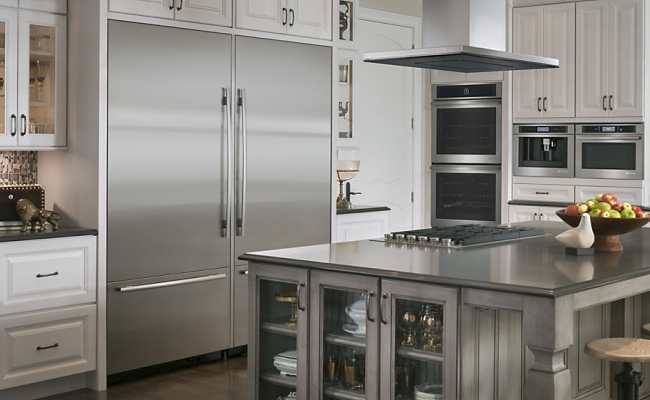
Seamless Integration: How RTA Kitchen Cabinetry Can Beautifully Accommodate Built-In Appliances
Share
The modern kitchen is increasingly defined by its sleek, integrated aesthetic. Built-in appliances, from refrigerators and ovens to microwaves and dishwashers, contribute to a streamlined and sophisticated look. While custom cabinetry has long been the go-to for achieving this seamless integration, ready-to-assemble (RTA) kitchen cabinetry has evolved to become a surprisingly versatile and budget-friendly option for housing your built-in culinary companions.
For homeowners seeking a stylish and functional kitchen without the hefty price tag of fully bespoke units, RTA cabinets offer a compelling solution. Let's explore how these flat-packed wonders can be expertly configured to accommodate your desired built-in appliances.
Understanding the Flexibility of RTA Cabinets:
The beauty of RTA cabinetry lies in its modularity. Designed for straightforward assembly, these cabinets come in a wide array of standard sizes and configurations. This inherent flexibility allows for creative planning and adaptation to incorporate various built-in appliances. While you might not have the unlimited customization of fully custom cabinets, the diverse range of available RTA options provides ample opportunity for seamless integration.
Key Strategies for Integrating Built-In Appliances with RTA Cabinets:
-
Dedicated Appliance Cabinets: Many RTA cabinet lines offer specific cabinets designed to house common built-in appliances. These include:
-
Oven/Microwave Combination Cabinets: These tall units feature openings of standard sizes to perfectly fit wall ovens and microwaves, often with drawers or cabinets above and below for additional storage.
- Built-In Refrigerator Panels and Surrounds: While a fully integrated refrigerator often requires specific panel-ready models, RTA manufacturers offer tall pantry cabinets and filler panels that can be used to create a framed look around a standard built-in refrigerator, giving it a more cohesive appearance.
-
Dishwasher Panels: Many RTA lines offer decorative end panels that can be used to conceal the side of a built-in dishwasher, blending it seamlessly with the surrounding cabinetry.
- Range Hood Cabinets: Specifically designed cabinets with appropriate ventilation cutouts ensure a proper and aesthetically pleasing installation of your built-in range hood.
-
Oven/Microwave Combination Cabinets: These tall units feature openings of standard sizes to perfectly fit wall ovens and microwaves, often with drawers or cabinets above and below for additional storage.
-
Strategic Use of Standard Cabinets: With careful planning, standard base and wall cabinets can also be adapted to accommodate certain built-in appliances:
- Built-In Microwave Drawers: Standard base cabinets can often be modified or selected in appropriate sizes to house built-in microwave drawers, creating a clean countertop.
- Integrated Cooktops: Base cabinets with sufficient countertop space can seamlessly integrate built-in cooktops. Ensure proper clearances and ventilation are accounted for during installation.
- Wine Refrigerators and Beverage Centers: Certain base cabinets can be selected to fit under-counter wine refrigerators or beverage centers, adding a touch of luxury and functionality.
-
The Importance of Precise Measurements and Planning: Successful integration hinges on accurate measurements of your appliances and careful planning of your cabinet layout. Before ordering your RTA cabinets, ensure you have the exact dimensions of all your built-in appliances, including their required clearances for proper operation and ventilation. Work closely with your cabinet supplier or a kitchen designer to select the right cabinet sizes and configurations to accommodate these dimensions.
-
Utilizing Filler Panels and End Panels: Filler panels are essential for bridging gaps between cabinets and walls, and they play a crucial role in creating a flush, built-in look around appliances. Decorative end panels can be used to finish exposed cabinet sides and further enhance the integrated aesthetic.
-
Considering Installation Expertise: While RTA cabinets are designed for relatively easy assembly, installing them around built-in appliances requires precision and attention to detail. If you're not comfortable with the process, hiring a professional installer experienced with RTA cabinetry and appliance integration is highly recommended. They can ensure proper leveling, secure installation, and adherence to manufacturer guidelines for appliance clearances.
Benefits of Using RTA Cabinets for Built-In Appliances:
-
Cost-Effectiveness: RTA cabinets offer significant cost savings compared to custom cabinetry, making a stylish kitchen with built-in appliances more accessible.
-
Variety of Styles and Finishes: The RTA market offers a wide range of styles, materials, and finishes to complement any kitchen design, allowing you to achieve your desired aesthetic.
-
Faster Lead Times: Compared to custom orders, RTA cabinets typically have shorter lead times, allowing for a quicker renovation process.
-
Flexibility in Design: The modular nature of RTA cabinets allows for a degree of customization and adaptation to fit various appliance sizes and kitchen layouts.
In Conclusion:
RTA kitchen cabinetry is no longer a compromise for budget-conscious homeowners. With careful planning, the selection of appropriate cabinet styles, and precise installation, RTA cabinets can beautifully and seamlessly accommodate a wide range of built-in kitchen appliances. By leveraging dedicated appliance cabinets, strategically using standard units, and paying close attention to measurements and installation, you can achieve the sophisticated, integrated look you desire without breaking the bank. Embracing the versatility of RTA cabinetry opens up a world of design possibilities for creating a modern and functional kitchen tailored to your needs and style.
